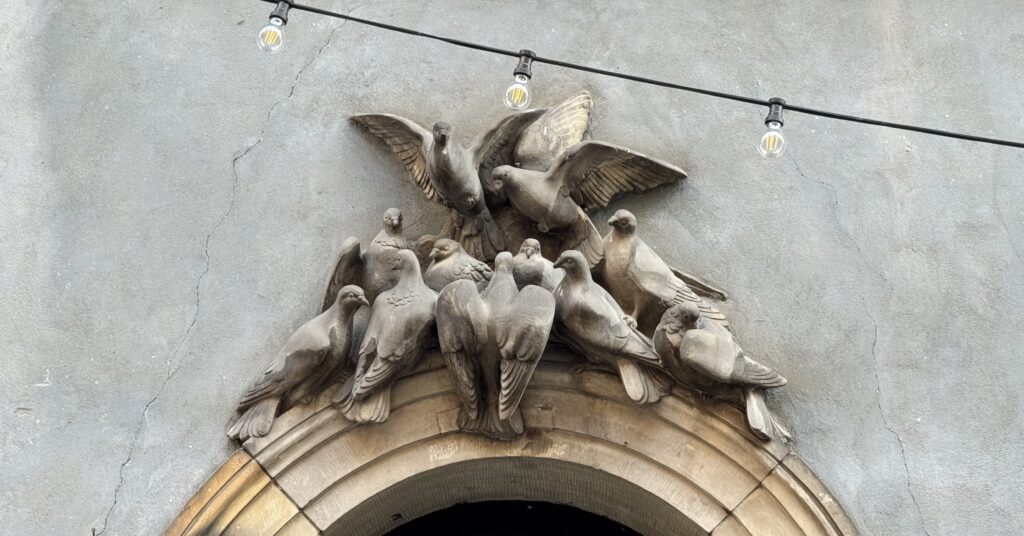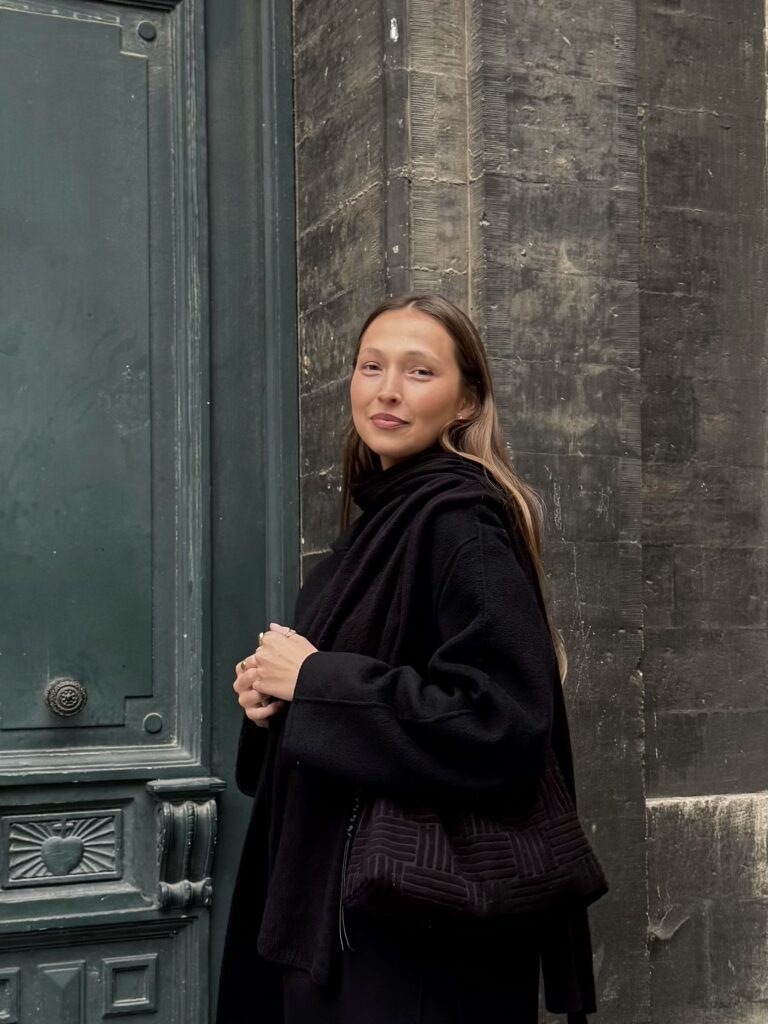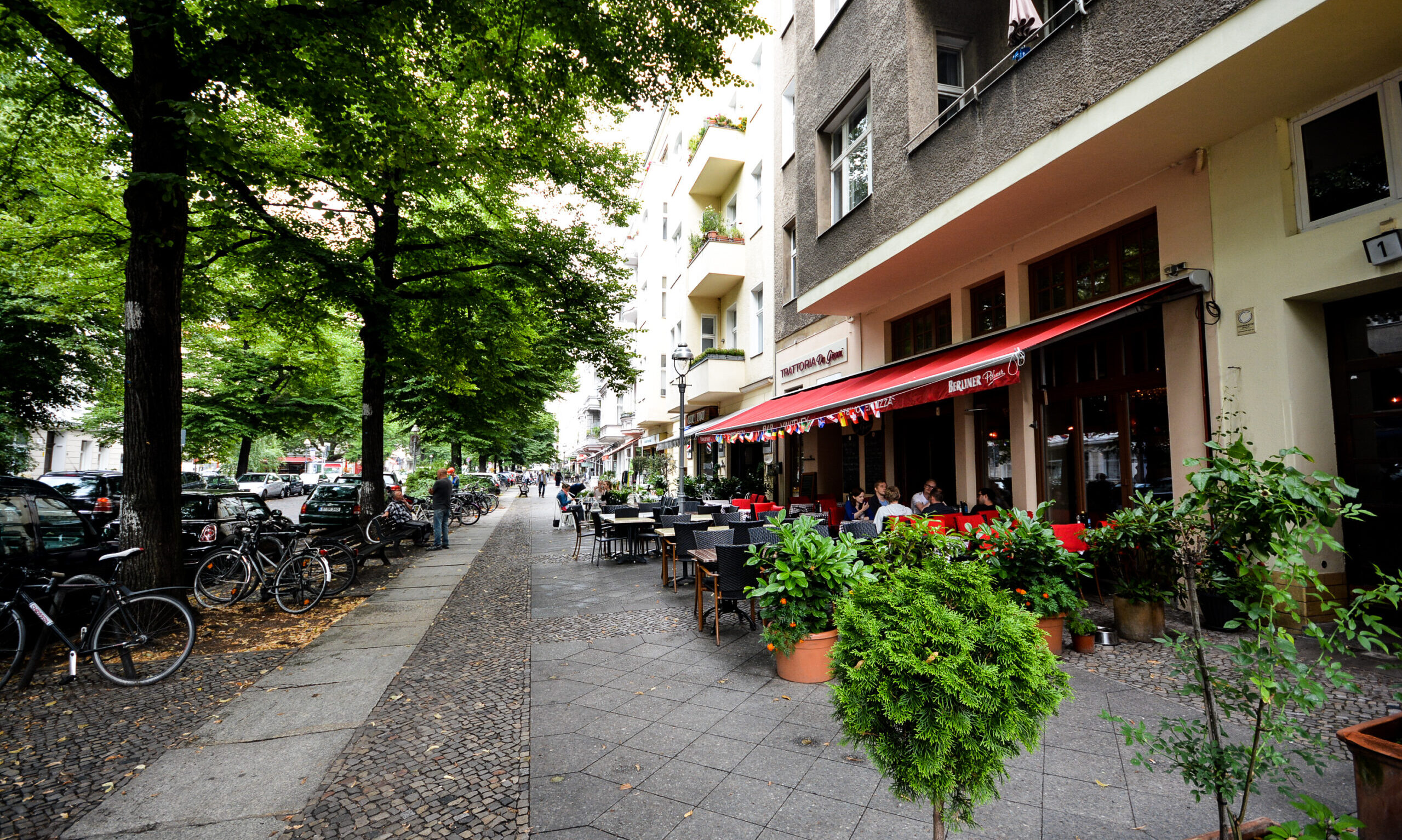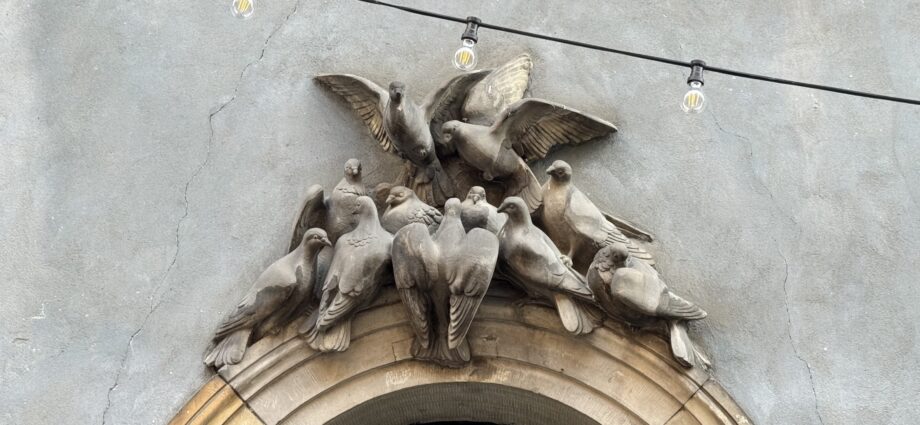By Savannah Siekierski
Savannah is currently doing her Master’s level internship at Pedestrian Space. As part of her internship with us, she is crafting ‘notes from the field’ from her research to share here. This is the third in a series of media field notes she is producing related to her research.

“People stop, take photos, and have no idea what it’s about,” someone told me last week during a walking interview in Warsaw’s Old Town. We were passing a small stone bas-relief above a doorway at Piwna 6, depicting a flock of pigeons. I must have seen it many times before, but what is it about, then?
Right after the end of World War II, the townhouse at Piwna 6 was largely destroyed, as was most of the built fabric of the Old Town. Among the ruins lived Kazimiera Majchrzak, a retired bank clerk who had been known before the war for feeding pigeons around Castle Square. When she returned to the devastated city in 1945, she transformed the remains of this house into a refuge for hundreds of birds. She fed them daily, buying grain and bread from her small pension and from donations collected in a bowl in front of the house. She knew her birds by name, tending to the sick and the injured, sharing her makeshift home and what little food she had.

A newspaper article from 1946 described her as “purple with cold, wrapped in rags, stepping onto her doorstep to welcome the birds landing on her shoulders and hands.” The same article went on to urge people to offer help, appealing directly to city scouts, as well as to representatives of the Society for the Protection of Animals and Social Welfare, to pay the woman a visit and offer bread and grain to her and her birds. Birds that the rest of society seemed to have forgotten amid the desolation of post-war Warsaw, yet which had long been an inseparable element of Warsaw’s Old Town. Even today, the pigeons remain part of the district’s defining scenery and soundscape, with a mention of a sudden, powerful flutter of their wings appearing in the virtual walk created by the Museum of Warsaw.
Kazimiera Majchrzak died in 1947, shortly after she was forced to relocate during the reconstruction of the Old Town, yet her presence lingers in local memory — in photographs, film chronicles, articles, drawings, and even poems. When the building at Piwna 6 was rebuilt between 1952 and 1953, the new stone portal was adorned with a small bas-relief depicting a group of pigeons, designed by architect Halina Kosmólska and sculpted by Jadwiga Karwowska. The sculpture, somewhat modest next to the many colorful and ornate facades in the area, was meant to commemorate Kazimiera Majchrzak, one of the first post-war residents of the street and the caretaker of the Old Town’s pigeons, a symbol of life returning to the destroyed city.
A couple of days after the walking interview, I returned to the building with my father and his friend to show them the sculpture. As we stood in front of it, a young woman with a pram stopped as well. I struck up a very brief conversation and we exchanged some fragments of the story we each remembered, connecting over this history of the compassionate figure. This small, pleasant encounter shows how stories like this continue to live on through elements of urban design — a micro-history of care and compassion, preserved not in archives but in stone and conversation.



Savannah Siekierski is a Master’s student in Urban Studies at ULB/VUB in Brussels, while also holding previous bachelor’s and master’s degrees in Psychology and Cognitive Neuroscience. She is particularly interested in bridging these fields with urbanism to explore how people feel, perceive, and connect to their environments. Her research focuses on the subjective and sensory experience of urban space, with a special emphasis on walking as an embodied practice. Savannah joined Pedestrian Space as an intern to align her academic interests in the psychology of urban experience with the organization’s focus on participatory advocacy and resident-centered urban perspectives. During her internship, she is pursuing research in Warsaw through methods such as auto-ethnography and walking interviews. Alongside her fieldwork, she is also contributing a media diary reflecting on her process and offering insights into walkability and urban life.
Sources:
Ficowski, J. (1959). Wspominki starowarszawskie. Karty z raptularza. Czytelnik.
Gazeta Ludowa. (1946, November 13). Harcerze, idźcie na Piwną obronić od głodu gołębie i człowieka. Gazeta Ludowa. https://mbc.cyfrowemazowsze.pl/Content/60431/PDF/00062890%20- %20Gazeta%20Ludowa%201946%20nr%20312%20-%20P10125.pdf
Łoziński, J. Z., & Rottermund, A. (1993). Katalog zabytków sztuki w Polsce. Seria nowa, t. 11: Miasto Warszawa, cz. 1: Stare Miasto. Wydawnictwa Artystyczne i Filmowe.
Muzeum Warszawy. (2020, December 22). Odbudowa Starego Miasta. Wirtualny spacer [Video]. YouTube. https://www.youtube.com/watch?v=GP6xPcyCdMA
Rolińska, J. (2022, December 30). Gołębiarka z Piwnej. Varsavianista. https://varsavianista.pl/index.php/ 2022/12/30/golebiarka-z-piwnej/
Ulicami Warszawy. (2017, June 4). Kamienica pod Gołębiami przy Piwnej 6. https:// ulicamiwarszawy.blogspot.com/2017/06/kamienica-pod-goebiami-przy-piwnej-6.html
Images:
Top photograph: by author
Bottom photograph: Capa, R. (1948, October). Woman feeding pigeons in the street, Warsaw; Poland [Photograph]. The Robert Capa and Cornell Capa Archive, Gift of Cornell and Edith Capa. International Center of Photography. https://www.icp.org/browse/archive/objects/woman-feeding-pigeons-in-the street-warsaw-poland
Bottom left drawing: Bartoszewicz, W., J. (1954). Gołębiarka z ulicy Piwnej. [Drawing]. Muzeum Warszawy.
Bottom right drawing: Bartoszewicz, W., J. (1954). Gołębiarka z ulicy Piwnej [Drawing]. Muzeum Warszawy.

